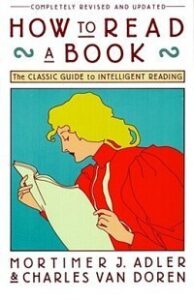
We live in an age of information overload. News and opinions bombard us from all directions through social media, websites, and notifications. It’s easy to fall into the habit of just skimming headlines and snippets without really digesting anything.
But true understanding and proper reading require focus and effort. It requires slowing down and actively engaging with what you’re reading rather than passively consuming content in tiny, disjointed pieces that are only surface-deep.
We have gotten lazy. We’ve forgotten what it means to really read something—to think deeply about ideas, to turn them over in our minds and to wrestle with opposing viewpoints. We’ve replaced reading with “anti-reading”—briefly scanning words just long enough to form snap judgments and move on to the next distraction.
This lazy, superficial way of consuming information is ruining our ability to learn and think critically. When we skim, our brains don’t fully process and retain what we’re reading. Ideas slip through our minds without leaving an impression. Complex topics get reduced to simplistic headlines that fail to capture nuance. Before long, we can’t even remember the details of what we “read.”
Worse, anti-reading promotes reaction and polarization over reflection. It’s easy to scroll past a headline that challenges our beliefs without giving its arguments a fair hearing. But understanding requires making an effort to see other perspectives, however uncomfortable they may be.
So in this age of endless content, we must resist the urge to just skim and scroll. We must make active reading a priority. We must slow down, focus, and fully engage with what we consume. We must think deeply rather than thoughtlessly react. Only then can we start to reap the intellectual and personal benefits that come from truly grappling with ideas rather than superficial exposure to them. It’s time to put in the work again and start actually reading.
Unlock the Power of Active Reading: Dive Deep with ‘How To Read A Book’ by Mortimer J. Adler

Are you tired of mindlessly scrolling through endless content without truly absorbing anything? Do you find yourself struggling to remember what you read or lacking the ability to think critically about ideas? It’s time to rediscover the lost art of active reading. In his book “How to Read,” Mortimer Adler provides a guide to help you break free from the superficiality of modern reading habits and engage with texts in a meaningful way. Adler emphasizes the importance of slowing down, asking questions, taking notes, and challenging assumptions. By actively grappling with ideas, you can develop a deeper understanding and reap the intellectual and personal benefits that come from true engagement with literature. So, if you’re ready to escape the cycle of passive consumption and embark on a journey of enlightenment, “How to Read” is the book for you. It’s time to reclaim the joy and power of reading.
You Know You’re Not Really Reading
Let’s be real – there’s no such thing as “passive reading.” All reading requires some level of active engagement from our brains. Even when we’re just skimming words on a page, our eyes and minds are working to process language.
But not all reading is created equal. Just because our eyes sweep over text doesn’t mean our brains are fully absorbing and critically analyzing what they see. That’s where “active reading” comes in.
Active reading is reading with intent. It’s reading for meaning, not reading for completion. It’s actively questioning ideas, not just accepting what we are reading. It’s visualizing concepts, making connections, and challenging assumptions – not just absorbing words into thoughts without reflection.
The best readers don’t just scan words – they wrestle with them. They think about how the ideas fit together. They evaluate arguments on both sides of an issue rather than accepting any one perspective without scrutiny. They relate what they’re reading to other topics and experiences to build a richer understanding.
When we read actively, we stay engaged with difficult material. We slow down when complexity goes up. We re-read challenging passages until they click. We jot down notes, ask questions of the text, and discuss our insights with others.
So if you find your eyes glazing over as you read or you can’t remember a single point from the last page, take a step back. Stop fooling yourself into thinking you’re reading at all. It’s time to start reading actively – to truly grapple with ideas instead of just consuming them in a low-effort stupor. Your brain will thank you for it, I promise.
The Active Reading Checklist (That Might Actually Enlighten You)
We’ve all been there – you start reading with good intentions to learn something new, but before you know it you’re scrolling Instagram with no clue what the text was even about. Here’s a checklist to help you actively engage with reading for actual enlightenment instead of mindless consumption:
- Preview the material. Skim introductions, headings, and conclusions to get the overall structure and argument before diving in. Know where you’re going before you start.
- Ask questions. Formulate questions you want answered as you read. Highlight passages you want to revisit and discuss your questions with others. Stay curious.
- Slow down. Reading shouldn’t be a race. Take time to reflect on challenging ideas rather than gloss over them. Reread complex sections until you understand them on a deeper level.
- Take notes. Jot down your thoughts, connections you make, and questions the text brings up. Writing aids retention far better than just passive reading. Your notes are for you, so don’t worry about perfection.
- Discuss what you’re learning. Talk about the material with others to test your understanding from multiple perspectives. Explain concepts in your own words. Teaching others is the best way to truly learn yourself.
- Connect ideas to your life. Relate what you read to your experiences to make the abstract more concrete. Seek real-world examples that bring theory to life.
- Challenge assumptions. Question the author’s perspectives. Evaluate arguments on both sides of an issue rather than accepting any one view without scrutiny. Think critically, not passively.
- Re-read for insight, not completion. Reread sections that were particularly thought-provoking or confusing, not just to cross it off your list. Insight often comes from lingering with difficult ideas.
So in summary – slow your ass down, engage actively, and actually think about what you read for once. Enlightenment awaits on the other side of passive consumption. The choice is yours.
